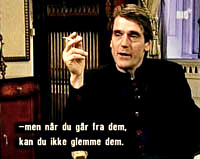p.o.v.
Number 12, December 2001 [PDF]CONTENTS
American and European Cinema
Introduction
- Comparing American and European Cinema
Mette Madsen: Art versus McBurger dramaturgy
An interview with Jon Bang CarlsenMM: Wherever I lay my hat
An interview with Ole MichelsenMM: "No, but I like American films - doesn't everybody?"
An interview with Mark LeFanuFrancesco Caviglia: Looking for male Italian adulthood, old style
Peder Grøngaard: For Ever Godard.
Two or three things I know about European and American cinemaEdvin Vestergaard Kau: What you see is what you get.
Reflections on European and American film practicesRay Keyes: Always leave'em wanting more
Richard Raskin: European versus American storytelling:
The case of The Third ManNiels Weisberg: Guilty pleasures
- Comparing American and European Television
Hanne Bruun: Entertainment Talk on Television
Nancy Graham Holm: Radio with Pictures
- Comparing American and European Practices in Other Media
Henrik Bødker: Transatlantic blues, music across the divide(s).
Cultural appropriation or the communication of essentials?Per Jauert: Formats in Radio Broadcasting
- the American-Danish connectionSøren Kolstrup: European and American press photography
Introduction | to the top of the page |
|
Richard Raskin, Editor
30 September 2001
to the top of the page
|
|
